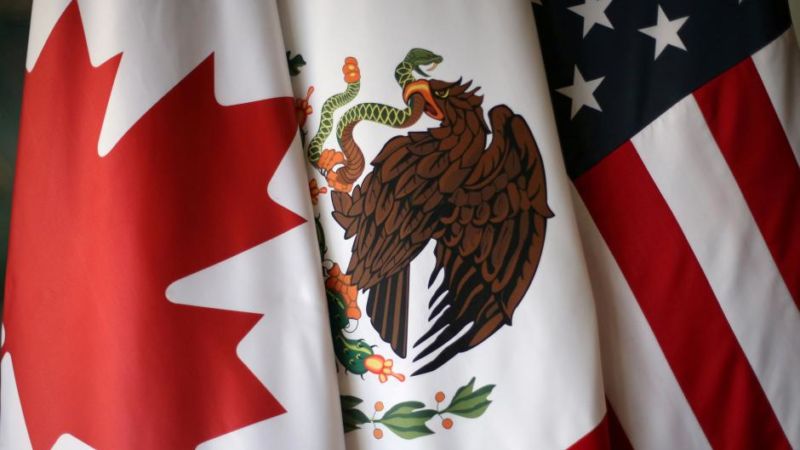After months of strong negotiations, the United States, Mexico and Canada have agreed on the rules of the new USMCA, the new free trade agreement that will replace NAFTA. An agreement that will have the United States as a major player, with Mexico and Canada quietly increasing their bilateral trade to give greater use to the treaty and reduce their commercial dependence on the United States.
Back in September, the United States, Mexico and Canada completed negotiations of the new United States Mexico Canada Agreement or USMCA, finally ending the long uncertainty of possibly not having an agreement at all. USMCA is replacing the North American Free Trade Agreement (NAFTA), a trilateral free trade zone agreement of almost three decades of existence, with a volume of operations reaching over 1.2 trillion dollars.
This trade agreement has always had a dominant player, with two partners who had very little in common. For the United States, trade with Canada and Mexico represents about 34% of its total foreign trade, followed by China with 8.4%. In contrast, for Mexico, the United States market represents almost 80% of its foreign trade, while Canada represents less than 3%. From Canada’s perspective, the relationship is similar, trade with the United States amounts to 76% of their exports, and less than 1.5% with Mexico.
With the current economic climate, it is safe to say that both Mexico and Canada would benefit from a continued bilateral agreement with the United States. Although the volume of operations between Mexico and Canada seems insignificant when compared to the U.S., both countries would benefit from the economic growth that the new trade deal will bring, and in turn, would help reduce their dependencies on the United States.
Although both Mexico and Canada are two of the most open trade economies in the world, with opportunities to explore and diversify within trade markets by using free trade agreements, this growth can also happen within the new USMCA deal, where bilateral trade between the two has multiplied eight times since the beginning of its implementation.
Sustainable Growth
In absolute terms, Mexico is the third most important commercial partner in Canada, while, from the perspective of Mexico, Canada ranks second. According to Canadian government figures, the volume traded between the two in 2017 reached 33 billion dollars.
In regard to direct investment, Canada allocated more than 13 billion dollars to Mexico, while direct Mexican investment in Canada amounted to about 1,300 million dollars, in both cases since the beginning of NAFTA.
In analyzing sector by sector, out of the 24 million dollars exported from Mexico to Canada in 2016, 32.23% comes from the automotive industry, followed by the electronics industry at 20.62% and machinery coming in last at 20.07% (Source: Atlas of Economic Complexity – Harvard University)
From Canada to Mexico, we saw exports of 9 million dollars within the same year. The food industry accounted for 20.57%, followed by the automotive industry at 17.64%, chemicals with 15.77%, metallurgy at 14.78% and machinery at 14.32% (Source: Atlas of Economic Complexity – Harvard University)
How This Will Work
Focusing on those sectors that offer inverse trade balances in relation to the other country, from Mexico’s perspective there are plenty of growth opportunities for exports to Canada in the automotive industry. Mexico has grown enormously in the automotive sector, presenting a positive balance of over 50 billion dollars, and in the textile sector with almost 2 billion dollars. From Canada’s perspective, the greatest opportunity for growth within the Mexican market can be found within the mining sector, historically strong with more than 40 billion dollars in favor, and the sector of metallurgy with a margin of more than two billion dollars (Source: Atlas of Economic Complexity – Harvard University).
Bilateral Relations
This growing relationship between Canada and Mexico can be seen not only in the flow of goods and investment, but also in the united front they have presented when dealing with negotiations with the United States. Negotiations and policies that will affect both countries, especially when it comes to labor laws, like those imposed for temporary agricultural workers and tourism, especially those affecting Mexican students who take advantage of bilateral agreements to improve their English language skills in Canadian universities.
Ensuring Compliance
Regardless of where the focus of foreign trade lies, all three countries has the use of free trade agreements and unparalleled opportunity to grow and diversify within their export markets. Mexico is the country with the largest number of trade agreements in the world. Mexico has commercial agreements signed with 45 countries, and with pending agreements to promote and protect investments with another 33 countries. This allows Mexico access to a market of over 1000 million customers, which represents 60% of the worlds GDP. The challenges of adapting to the correct use of these trade agreements is largely mitigated with the use of technology applied to foreign trade that allows for validation of these agreements between each export operation and the requirements in force.






